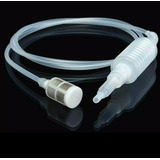Dave 666
Regular.
- Joined
- Jun 5, 2018
- Messages
- 347
- Reaction score
- 66
So, I syphoned and bottled my second (and first AG) brew today. Started off well, very clear already but soon encountered a problem.
My system was to syphon from the main FV into the small 10 litre FV. The second FV has the muslin cloth clamped over it and I syphon over this to filter out any remaining bits. Then syphon into bottles from that. Pretty simple and straight forwards I'd say. For this I'm using an east start syphon where its clipped onto the FV, a couple of pumps and I'm away. Only for some reason after half way syphoning things were getting more and more cloudy were as at the start the beer was as said already very clear. Of cause, I might add that I had to repump a number of times, so I'm guessing this simply mixed up the brew with the settled sediment.
Now in retrospect I could have simply left most of it in the second FV for a few days to settle again and written of the few litres I couldn't fit in. But I had spent an hour cleaning and sterilising my bottles and gear ready to bottle up, and thought sod it, just bottle it and it'll settle in there instead.
Time will tell how long its going to take (it it does) to settle in the bottles while it carbs at the same time. But kind of kicking myself now for not thinking to simply leave it a few days in the second FV as it would be less issues later.
So, any tips for future reference as I don't want this problem again?.
My system was to syphon from the main FV into the small 10 litre FV. The second FV has the muslin cloth clamped over it and I syphon over this to filter out any remaining bits. Then syphon into bottles from that. Pretty simple and straight forwards I'd say. For this I'm using an east start syphon where its clipped onto the FV, a couple of pumps and I'm away. Only for some reason after half way syphoning things were getting more and more cloudy were as at the start the beer was as said already very clear. Of cause, I might add that I had to repump a number of times, so I'm guessing this simply mixed up the brew with the settled sediment.
Now in retrospect I could have simply left most of it in the second FV for a few days to settle again and written of the few litres I couldn't fit in. But I had spent an hour cleaning and sterilising my bottles and gear ready to bottle up, and thought sod it, just bottle it and it'll settle in there instead.
Time will tell how long its going to take (it it does) to settle in the bottles while it carbs at the same time. But kind of kicking myself now for not thinking to simply leave it a few days in the second FV as it would be less issues later.
So, any tips for future reference as I don't want this problem again?.








